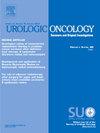Differential response of low- and high-grade intermediate-risk non-muscle-invasive bladder cancer to bacillus Calmette-Guérin and gemcitabine-docetaxel therapy
IF 2.4
3区 医学
Q3 ONCOLOGY
Urologic Oncology-seminars and Original Investigations
Pub Date : 2025-03-31
DOI:10.1016/j.urolonc.2025.03.009
引用次数: 0
Abstract
Background and Objective
Sequential intravesical gemcitabine/docetaxel (Gem/Doce) is a potential alternative to bacillus Calmette-Guérin (BCG) for treating non-muscle-invasive bladder cancer (NMIBC). Intermediate-risk NMIBC group (IR-NMIBC) includes both low-grade (LG) and high-grade tumors (HG). This study investigates the response of HG and LG IR-NMIBC to Gem/Doce compared to BCG therapy.
Methods
We included patients with IR-NMIBC who received either BCG or Gem/Doce between 2013 and 2023. Maintenance regimens were administered to patients without recurrence after induction for 1 year. Follow-up cystoscopies were performed per American Urological Association (AUA) guidelines. Kaplan-Meier and Cox regression analyses were performed to evaluate recurrence-free survival (RFS) and progression-free survival (PFS).
Results
Among 505 NMIBC patients, 150 were IR-NMIBC: 115 with HG tumors (69 received BCG, 46 received Gem/Doce) and 35 with LG tumors (14 received BCG, 21 received Gem/Doce).With a median follow-up time of 31 months (Interquartile Range [IQR] 13–54), The overall 2-year any-grade RFS was 55%. For HG and LG groups, the 2-year any-grade RFS was 58% and 35% (P = 0.009), respectively. High-grade RFS at 2 years was 75% for HG and 94% for LG (P = 0.065). The 2-year PFS was similar between groups, at 96% for both HG and LG (P = 0.39). In HG patients, 2-year high-grade RFS was higher with BCG than Gem/Doce (81% vs. 59%, P = 0.008). In LG patients, 2-year any-grade and high-grade RFS were comparable between BCG and Gem/Doce (P = 0.067 and P = 0.37, respectively).
Conclusions
Our findings suggest that BCG may offer a superior benefit in terms of high-grade RFS for HG IR-NMIBC compared to Gem/Doce, while LG tumors respond similarly to both treatments. This emphasizes the role of risk stratification in treatment selection. Prospective studies are needed to validate these findings and refine treatment strategies.
低、高、中危非肌浸润性膀胱癌对卡介苗-谷氨酰胺和吉西他滨-多西他赛治疗的差异反应
背景和目的:序贯膀胱内注射吉西他滨/多西他赛(Gem/Doce)是治疗非肌肉浸润性膀胱癌(NMIBC)的潜在替代方案。中危NMIBC组(IR-NMIBC)包括低级别肿瘤(LG)和高级别肿瘤(HG)。本研究探讨HG和LG IR-NMIBC对Gem/Doce的反应,并与BCG治疗进行比较。方法:我们纳入了2013年至2023年间接受BCG或Gem/Doce治疗的IR-NMIBC患者。对诱导后无复发的患者给予维持方案1年。按照美国泌尿学协会(AUA)指南进行随访膀胱镜检查。Kaplan-Meier和Cox回归分析评估无复发生存期(RFS)和无进展生存期(PFS)。结果:505例NMIBC患者中,150例为IR-NMIBC; HG肿瘤115例(69例接受BCG, 46例接受Gem/Doce), LG肿瘤35例(14例接受BCG, 21例接受Gem/Doce)。中位随访时间为31个月(四分位间距[IQR] 13-54),总体2年任意级别RFS为55%。HG组和LG组2年任意分级RFS分别为58%和35% (P = 0.009)。HG患者2年高级别RFS为75%,LG患者为94% (P = 0.065)。两组间的2年PFS相似,HG和LG均为96% (P = 0.39)。在HG患者中,卡介苗组的2年高级别RFS高于Gem/Doce组(81% vs。59%, P = 0.008)。在LG患者中,BCG和Gem/Doce的2年任意级别和高级别RFS具有可比性(P = 0.067和P = 0.37)。结论:我们的研究结果表明,与Gem/Doce相比,BCG可能在HG IR-NMIBC的高级别RFS方面提供优越的益处,而LG肿瘤对两种治疗的反应相似。这强调了风险分层在治疗选择中的作用。需要前瞻性研究来验证这些发现并完善治疗策略。
本文章由计算机程序翻译,如有差异,请以英文原文为准。
求助全文
约1分钟内获得全文
求助全文
来源期刊
CiteScore
4.80
自引率
3.70%
发文量
297
审稿时长
7.6 weeks
期刊介绍:
Urologic Oncology: Seminars and Original Investigations is the official journal of the Society of Urologic Oncology. The journal publishes practical, timely, and relevant clinical and basic science research articles which address any aspect of urologic oncology. Each issue comprises original research, news and topics, survey articles providing short commentaries on other important articles in the urologic oncology literature, and reviews including an in-depth Seminar examining a specific clinical dilemma. The journal periodically publishes supplement issues devoted to areas of current interest to the urologic oncology community. Articles published are of interest to researchers and the clinicians involved in the practice of urologic oncology including urologists, oncologists, and radiologists.

 求助内容:
求助内容: 应助结果提醒方式:
应助结果提醒方式:


